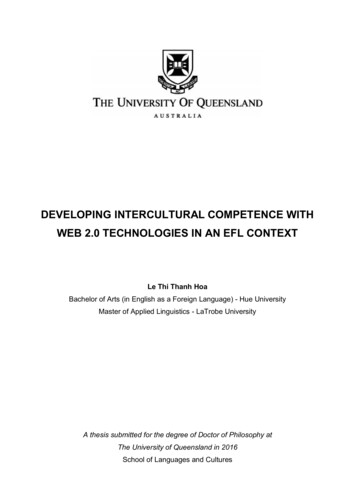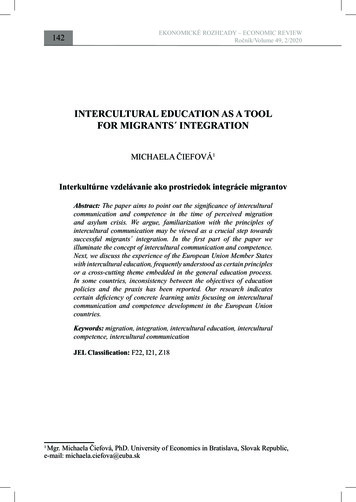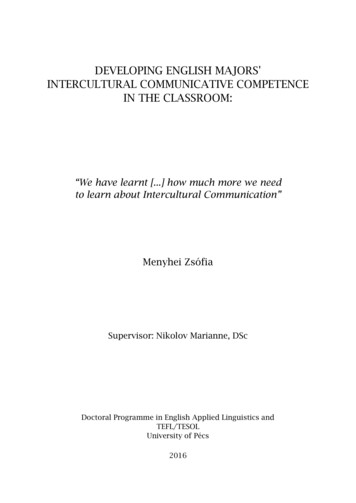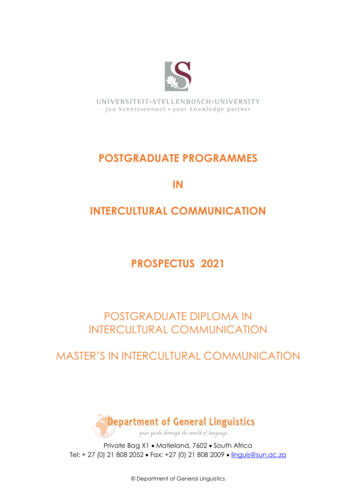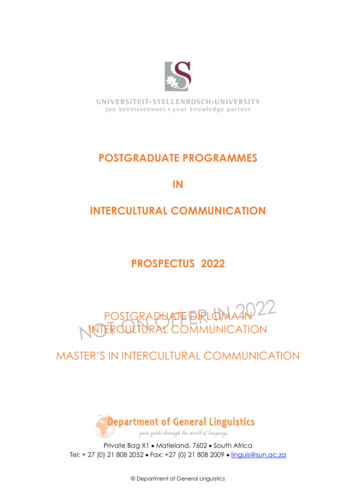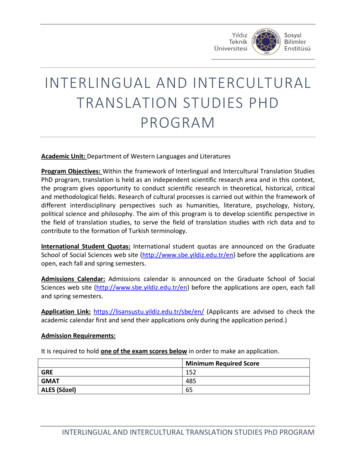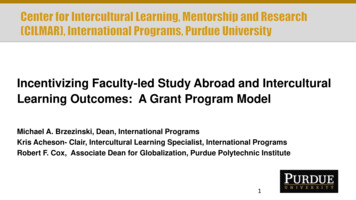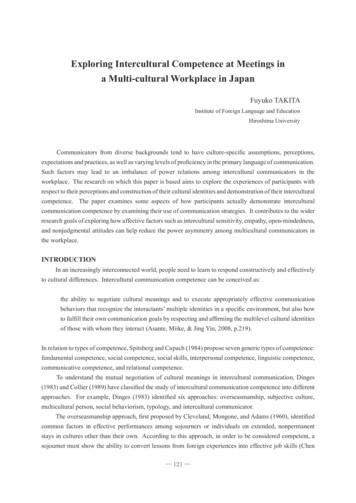
Transcription
Exploring Intercultural Competence at Meetings ina Multi-cultural Workplace in JapanFuyuko TAKITAInstitute of Foreign Language and EducationHiroshima UniversityCommunicators from diverse backgrounds tend to have culture-specific assumptions, perceptions,expectations and practices, as well as varying levels of proficiency in the primary language of communication.Such factors may lead to an imbalance of power relations among intercultural communicators in theworkplace. The research on which this paper is based aims to explore the experiences of participants withrespect to their perceptions and construction of their cultural identities and demonstration of their interculturalcompetence. The paper examines some aspects of how participants actually demonstrate interculturalcommunication competence by examining their use of communication strategies. It contributes to the widerresearch goals of exploring how affective factors such as intercultural sensitivity, empathy, open-mindedness,and nonjudgmental attitudes can help reduce the power asymmetry among multicultural communicators inthe workplace.INTRODUCTIONIn an increasingly interconnected world, people need to learn to respond constructively and effectivelyto cultural differences. Intercultural communication competence can be conceived as: the ability to negotiate cultural meanings and to execute appropriately effective communicationbehaviors that recognize the interactants’ multiple identities in a specific environment, but also howto fulfill their own communication goals by respecting and affirming the multilevel cultural identitiesof those with whom they interact (Asante, Miike, & Jing Yin, 2008, p.219).In relation to types of competence, Spitsberg and Cupach (1984) propose seven generic types of competence:fundamental competence, social competence, social skills, interpersonal competence, linguistic competence,communicative competence, and relational competence.To understand the mutual negotiation of cultural meanings in intercultural communication, Dinges(1983) and Collier (1989) have classified the study of intercultural communication competence into differentapproaches. For example, Dinges (1983) identified six approaches: overseasmanship, subjective culture,multicultural person, social behaviorism, typology, and intercultural communicator.The overseasmanship approach, first proposed by Cleveland, Mongone, and Adams (1960), identifiedcommon factors in effective performances among sojourners or individuals on extended, nonpermanentstays in cultures other than their own. According to this approach, in order to be considered competent, asojourner must show the ability to convert lessons from foreign experiences into effective job skills (Chen― 121 ―
Guo-Ming & Starosta, 2008, p.220). Second, the subjective culture approach requires individuals to havethe ability to understand the causes of interactants’ behaviors and reward them appropriately, and to modifytheir own behaviors suitably according to the demands of the setting (Trandis, 1976; 1997). Next, themulticultural person approach emphasizes that a competent person must be able to adapt to exceedinglydifficult circumstances by transcending his or her usual adaptive limits (Adler, 1975; 1982). According tothis approach, the individuals must learn to move in and out of different contexts, to maintain coherence indifferent situations. Regarding the social behaviorism approach, it emphasizes that successful interculturalcoping strategies depend more on the individual’s pre-departure experiences, such as training and sojourningin another country, than on inherent characteristics or personality (Guthrie, 1975). In contrast, the typologyapproach develops different models of intercultural communication competence. For instance, Brislin(1981) proposed that a successful intercultural interaction must be based on the sojourner’s attitudes, traits,and social skills. He argued that non-ethnocentrism and non-prejudicial judgments are the most valuableattitudes for effective intercultural interaction. Ethnocentrism is “the judgment of an unfamiliar practice bythe standards and norms familiar to one’s own group or culture” (Brislin, 1981). The major adaptive personaltraits Brislin identifies as important for intercultural communication are strength of personality, intelligence,tolerance, social relations skills, recognition of potential for benefit, and task orientation. Important socialskills that he advocates are knowledge of subject and language, positive orientation to opportunities, effectivecommunication skills, and the ability to use personal traits to complete tasks (Chen Guo-Ming & Starosta,2008, p.220).The intercultural communicator approach emphasizes the view that successful intercultural interactioncenters on communication processes among people from different cultures. According to this approach, itmeans that to be interculturally competent, an individual must be able to establish interpersonal relationshipsby understanding others through the effective exchange of verbal and nonverbal behaviors (Hall, 1959;1966; 1976). Further, the cultural identity approach assumes that communication competence is a dynamic,emergent process where interactants can improve the quality of their experience through the recognition ofthe existence of each other’s cultural identities (Collier, 1989; 1994; Cupach & Imamori, 1993). Thus,interculturally competent persons must know how to negotiate and respect the meanings of cultural symbolsand norms during their interactions (Colliers & Thomas, 1988). Additionally, Ward and Searle (1991) havefound that cultural identity significantly affects adaptation to new culture.All the approaches described provide useful information and perspectives from which to study andunderstand intercultural communication competence. However, Chen Guo-Ming and Starosta (2008) claimthat these approaches fail to give a holistic picture that can reflect the ‘global civic culture’. As we encountergreater cultural diversity, more study of intercultural communication competence becomes increasinglyimportant. Communicators from different cultures can only understand each other through investigatingeffective intercultural strategies demonstrated by interactants themselves in a globalized world. In order todeepen our understanding of intercultural competence, there is a necessity for all of us to learn more aboutourselves and members of cultures other than our own. Furthermore, if we perceive the balance of power asan issue for intercultural communication among communicators from different backgrounds and take aninterest in a critical perspective, we might be able to propose an approach that helps promote a more positivecooperative world.― 122 ―
METHODGoalThis paper is based on a study to examine whether participants demonstrate certain interculturalcommunicative competence and communications strategies in order to accommodate and cooperatewith each other in an intercultural setting. By discovering some of the communicative competence andcommunication strategies employed by participants in this study through discourse analysis, it can illustratehow those strategies can minimize the asymmetry of power relations among communicators from differentcultural and linguistic backgrounds, and promote more collaborative work to solve intercultural communicationproblems. In this paper, I analyze some examples of communication strategies used by participants.The overall study is based on analysis of transcribed data (meetings and interviews) and ethnographicobservations. The data for analysis came from an intercultural context of staff meetings among colleagueswithin a research institution in Japan. This particular institution was selected as a setting for data collectionbecause it has a long history of employing workers from different cultural and linguistic backgrounds.According to one of the workers in the institution, some workers experienced a tension among seniorscientists from different cultural and linguistic backgrounds. Thus, this particular setting is a valuable placefor evaluating whether there is a power imbalance among workers from different backgrounds. Furthermore,this setting offers the opportunity to investigate whether workers from different backgrounds employ anddemonstrate certain aspects of intercultural competence and communication strategies in an interculturalsetting. The analysis of the examples provided in the paper helps provide some insights for managing theimbalance of the power relations that could arise due to the insufficient employment of certain communicationstrategies.The researcher audio-recorded naturally occurring conversations in three staff meetings mainlyconducted in English. Two of the meetings were transcribed and analyzed using discourse analysis and anethnographic approach.ParticipantsBackground information about the participants is summarized in Table 1. They were told that theirprivacy and anonymity would be protected. Throughout this study, pseudonyms will be used, and forsensitive information or wording that could potentially compromise their anonymity, I will use “xxx”.The members of the department are L1 speakers of English, Japanese and Chinese. Although theEnglish proficiency levels of the participants were not tested, three of the L2 English speakers, including thetwo junior Japanese scientists, Koji and Yusuke, and one Taiwanese junior scientist, Lin, all lived and studiedat a university in the U.S. for several years and speak English fluently. ‘Fluent’ as used here means thatspeakers can carry out daily conversation and communicate their thoughts in English with little difficulty.However, Koji and Yusuke seem to have difficulty in expressing their opinions when the topics are related toscientific knowledge in the workplace, while Lin seems to have less difficulty in expressing them in her L2.Lin lived in the U.S. for more than twenty years; Koji and Yusuke lived there for less than eight years. Lin’sEnglish proficiency level seems to be higher than those of the Japanese junior scientists. It was assumed thatthe two Japanese junior scientists were approximately equal. However, the senior scientist, Yamamoto, hasmuch more limited English ability; he visited the U.S. only once for a short period of time to conduct his― 123 ―
TABLE 1. Participants’ ob titleYears/RC*L1American(Gary)Male58PhDSection Chief/Senior Scientist10EnglishAmerican(Don)Male55PhDFormer Section Chief/Senior Scientist21EnglishTaiwanese(Lin)Female44PhDJunior ScientistJapanese(Kakita)Femalen/aBAAdmin. or Scientist29JapaneseJapanese(Koji)Male41PhDJunior Scientist5JapaneseJapanese(Yusuke)Male41PhDJunior Scientist2Japanese6Chinese/English(English is L2)* Last names (Kakita and Yamamoto, both pseudonyms) instead of first names were used for senior Japanese participants inorder to highlight generational difference* RC means research center and n/a means not applicable.research, and his English level is lower compared to three other non-native speakers of English in thedepartment. He appeared to experience great difficulty in understanding what American senior scientistswere saying and hardly made any comments in English.ANALYSIS AND DISCUSSIONHere, I analyze communication strategies (CSs) used by certain participants during the meetings. Inorder to do this, the way that participants from different cultural backgrounds compensate for breakdownsand reduce their power relations needs to be examined.While inadequate language proficiency could cause some communication breakdowns and unbalancedpower relations in interaction, the use of CSs, such as code switching, appeals for assistance, and clarificationrequests, can help communicators facilitate effective communication in collaboration. This means that, evenwith limited linguistic competence, communicators from different cultural backgrounds can still have asmoother interaction and more balanced power relations through the use of CSs.First, a code-switching strategy is discussed since speakers try to use this strategy to solve problems byexpanding their communicative resources. Extract 1 shows an example of how Gary and Koji use codeswitching.Extract 11. Japanese Administrator: Ohanami wa nashi? (so, there is no hanami?)2. Gary: I don’t know. I am not a big believer in this jisyuku business. I am wagamama,(selfish), but haha.― 124 ―
3. Koji: What’s the word for jisyuku? Self-control or self-restraint?4. Gary: To me, self-restraint is the dictionary definition, but I think it’s more like selfdenial or asceticism, Haha. Like monks, monastic, you know monks that denythemselves the worldly pleasures, but Code-switching is an achievement strategy proposed by Færch and Kasper (1983). In communicationwhere foreign languages are involved “there always exists the possibility of switching from L2 to either L1or another language” (Færch and Kasper, 1983, p.46). In addition to the use of code-switching, Koji alsouses literal translation, which is considered to be an interlingual transfer (combination of linguistic featuresfrom the interlanguage and the first language). As displayed in this extract, Gary in utterance 2 attempts touse two Japanese words, jisyuku (self-restraint) and wagamama (selfish) in order to reduce a linguistic gapby expanding his communicative resource, which is his Japanese knowledge.Gary might have tried to compensate for the intercultural communication gap by utilizing the functionof code-switching as his CS to compensate for a linguistic gap. However, because the Japanese term jisyukuused by Gary has a different meaning from Koji’s definition in this context, it appears that they areexperiencing a communicative mismatch despite the use of code-switching as a strategy. Koji decides tosignal Gary that he needs assistance and makes use of the cooperative communication strategy of appealing.This move by Koji can be regarded as an appeal for assistance because he consults Gary to clarify themeaning of the word ‘jisyuku’.The next extract (extract 2) shows an example of interaction by Gary and Koji who demonstrate theuse of CSs to promote mutual collaboration.Extract 21. Gary: Really, we need to think about a person who will be good to be invited so, can anybody thinkof a name? Coz I need to send something back to Dr. X.2. Koji: Is there any requirement to include a Japanese presenter?3. Gary: I think for balance, it’s important to have someone from Japan on that, adding to the threemajors. Well, there will be four main presenters, so there will also be a person who would be acertain discussant, a summarizer, haha. Probably someone from here or.I will probably do itunless, unless we get someone else, but I would really like to find someone Japanese.4. Koji: What is the session title, by the way?5. Gary: XXX. How about Dr. Y?6. Koji: I will probably ask him.7. Gary: Maybe just ask him sort of informally. Ask him if he would be interested if he has suggestionsor that would be the best approach. Well, would it be best for you to contact him or for me tocontact him? First, initially Okay?8. Koji: By tomorrow?9. Gary: Yeah, if possible. Well, I’ll go back and look and see what Dr. X required.― 125 ―
As displayed in this interaction by Gary and Koji, communication both in terms of equality ofcontribution by the participants and effectiveness is observed through their use of CSs. For instance, anacceptance phase starts with Koji’s first move in utterance 2 that gives evidence that he understood what wasmeant by Gary. Koji understands that Gary is requesting to have an invited speaker, and Koji confirmswhether Gary is interested in having a Japanese speaker by asking “Is there any requirement to include aJapanese presenter?”. This process indicates that both Gary and Koji think they have a mutual belief thatKoji understood what Gary meant to add to their common ground.This type of approach is described in collaborative theory suggested by Clark and Wilkes-Gibbs (1986),and Wilkes-Gibbs (1997). In this theory, they consider conversation in any language as “a collaborativeprocess of coordinating individual beliefs into mutual ones; therefore, both participants discover and extendthe boundaries of common ground in every turn” (Clark & Wilkes-Gibbs, 1986). This process is called thegrounding process.Regarding this grounding process, Fujio (2011) explains that the “basic unit in grounding is thecontribution, that is an action or utterance by the participants to update their common ground” (p.46). Acontribution is “not necessarily a syntactical unit such as a grammatical sentence, but is rather an emergentstructure that develops through collective action” (p.46). Further, the grounding contribution is divided intoa presentation phase and an acceptance phase. In the acceptance phase, for example, speaker A presents anutterance for speaker B to consider, and in the acceptance phase, both speaker A and B “try to establish thatthey have a satisfactory mutual interpretation of the action” (Wilkes-Gibbs, 1997, p.240). For instance, inextract 8, Gary presents an utterance “so, can anybody think of a name?.” (utterance 1). Then, Koji givesan acceptance phase in utterance 2 saying “is there any requirement to include a Japanese speaker?”, whichindicates his satisfactory interpretation.According to Wilkes-Gibbs, “the grounding process can be recursive when an initial presentation byspeaker A does not work and a sign of non-understanding is shown by B in the following acceptance phase”(1997, p.242). In that case, Wilkes-Gibbs continues that “the initial presentation has to be refashioned untilboth participants reached the mutually satisfactory point” (p.242). The example of the simplest groundingprocess called ‘elementary’ is shown in utterance 6 by Koji. When Gary gives an initial presentation in turn5 saying “how about Dr. Y?” suggesting Dr. Y as a possible invited speaker, Koji immediately answerssaying that “I will probably ask him”, indicating his understanding of Gary’s request and accepting it. Then,in turn 4, Koji shows a sign of topic shift and asks Gary to refashion his initial presentation. Gary receivesKoji’s sign of clarification or confirmation request by answering “XXX” then refashions his presentationsaying “How about Dr. Y?” in turn 5. Since Koji then accepts Gary’s request by saying “I will probably askhim” in turn 6, it indicates that both participants eventually reached a mutually satisfactory point.In utterance 7, Gary carefully asks Koji whether it is better for Koji to contact Dr. Y or for Gary tocontact him directly. Gary asks “first, initially Okay?” which is regarded as a restatement. By repeating theword ‘first” and ‘initially’ which have similar meanings, this strategy of repetition is regarded as restatementin the taxonomy of CSs. Furthermore, Gary puts ‘Okay?’ at the end of his utterance in order to negotiate hiscommunication breakdown with Koji. This is also a strategy used by Gary who attempts to minimize Koji’seffort to overcome a linguistic problem. Then, interestingly in utterance 8, Koji does not directly answerGary’s question, but instead he shifts his topic and asks whether the contact needs to be taken by ‘tomorrow’.― 126 ―
In some cases, a non-native speaker stops his/her acceptance phase with the first move by answeringyes or no in L2 communication. For instance, NS participants often no longer convey their understanding,and do not extend the common ground. However, Koji shows the sign of his understanding of Gary’s requestand implies that he (Koji) will make a contact by confirming the deadline of the contact with Dr. Y. Then inline 9, Gary agrees and answers Koji’s confirmation request by saying “yeah, if possible”. As can be seenthroughout this interaction by Gary and Koji, they communicated in a flexible manner and stayed sensitiveto the on-going text by showing collaborative efforts.The example demonstrates that successful intercultural communication could be considered as thesituation in which both L1 and L2 participants try collaboratively to understand adequately and effectively.Because participants try to have fewer breakdowns, they resort to some CSs which can help to prevent them.Specific CSs such as clarification requests or confirmation checks were employed by the participants in themeeting in order to facilitate the interlocutor’s understanding in their presentation phase. Furthermore, someCSs such as code-switching and appeals for assistance were employed strategically in order to facilitatemutual understanding. These showed that, from the viewpoint of a principle of mutual responsibility and aprinciple of least effort in collaboration proposed by Wilkes-Gibbs, such CSs are effective interculturalcommunication tools used in order to balance unequal power relations among communicators from differentcultural and linguistic backgrounds.To illustrate other CSs used by participants in the meeting, extract 10 demonstrates how Koji and aJapanese administrator use a topic avoidance strategy and message abandonment proposed by Tarone (1983).It is a refusal to enter into or continue a discourse within a particular field or topic due to a feeling of totallinguistic inadequacy (Corder, 1978). In topic avoidance, “the learner simply tries not to talk about the topicor a concept that he or she is not familiar with”, and in message abandonment, “the learner begins to talkabout a concept but is unable to continue and stops in mid-utterance” (Tarone, 1983, pp.62-63).Extract 31. Gary: Is there, is there anything in the, in the news, sakura zensen no? [seasonal indicatorfor cherry blossom season across Japan]2. Japanese admin: No, maybe ano [well] we can 3. Gary: (2.0 of silence)4. Koji: Jisyuku [self-restraint].5. Gary: (2.0 of silence) Oh, no one is gonna have hanami this year, you think? (soundssurprised)6. Koji: Probably fewer[ than 7. Gary: [ Fewer?8. Koji: (3.0 of silence)9. Don: Oh, because of the disaster, yeah.As seen in the interaction above, Gary as an L1 speaker seems to assume that his use of code-switching,‘sakura zensen no’, would minimize the linguistic balance for the NNS. However, the Japanese administratorcannot easily convey her messages because her linguistic resources do not permit her to express them― 127 ―
successfully. In the course of this interaction, the administrator seems to find herself faced in this situationin turn 2. Instead of trying to convey her message using the resources available to her, the administratorchooses to end her turn and avoid taking a risk of communicating. This type of strategy is called ‘topicavoidance strategy’.A less extreme form of topic avoidance that Koji uses is ‘message abandonment’ employed by Koji inturn 6. Koji at least tries to answer Gary’s question by replying “probably fewer than ” but gives upconveying his message in the middle of his turn. Although Koji first employed the message abandonmentstrategy by showing his attempt to utilize his linguistic resources available, he then switches to a topicavoidance strategy by not saying anything in turn 8. Gary employs a confirmation check by repeating Koji’sword “fewer?” in turn 6 to find out what Koji meant. However, Koji decides to be silent and not to reply inorder to avoid further communicative misunderstanding or communication breakdown.Koji’s use of an abandonment strategy was not completely successful because he simply gave up anddid not attempt to expand his resources to realize his communicative intentions. It is likely that Koji usedthis strategy because he wanted to avoid making errors due to his linguistic inadequacy. However, Dondemonstrates his intercultural competence by showing his understanding and interpretation of what Kojiintended to say. Don expressed his assumption of the tsunami disaster being the reason why there are fewerpeople who wanted to have an ohanami party this year. In this case, Don resorted to a risk-taking strategyby guessing Koji’s intended message and expressing it.While Koji decided to signal that he was experiencing a communication problem by abandoning thetopic, Don sensed that Koji needed assistance and made use of the cooperative communication strategy. Inthis kind of communicative situation where one of the communicators has a linguistic disadvantage, thecommunicators from different backgrounds can change the distribution of roles in such a way that thecommunicative task is reduced for the linguistically disadvantaged communicator.CONCLUSIONIn this paper, I have documented and analyzed some of the communication strategies used in anintercultural setting at an institute in Japan. I have explored how participants demonstrated interculturalcommunication strategies such as code-switching, appeals for assistance, topic avoidance and messageabandonment in meeting interaction.In the broader context of the overall study, the notions of power relations and interactional dominanceamong scientists from different cultural backgrounds in department meetings have been explored. Resultsrevealed that interactional dominance by some participants manifested itself culturally and linguisticallyin the meetings, with some participants demonstrating interactional dominance. However, speakers withintercultural competence possess the ability to negotiate cultural meanings and to execute effectivecommunication behaviors in a specific environment by fulfilling their own communication goals.As observed in the collaborative approach used by Gary and Koji in extract 3, successful interculturalcommunication by L1 and L2 speakers is considered to be the situation in which both participants attempt tounderstand adequately and effectively. It means that the participants’ efforts can be minimized and madeeconomical by having fewer breakdowns and recovering from them quickly. In intercultural communication,because participants cannot utilize their shared knowledge and communication practices as they can do so in― 128 ―
purely L1 communication, they need to use CSs more frequently in order to have a smoother interaction andmore balanced power relations. This paper has illustrated how some of those CSs are used.REFERENCESAsante, M., Miike, Y. and Yin, J. (2008). The Global Intercultural Communication Reader. New York:Routledge.Brislin, R. W. (1981). Cross-cultural Encounters: Face-to-face interaction. Elmsford, NY: Pergamon.Cleveland, H., Mangone, J., & Adams, C. (1960). The Overseas Americans. New York: McGraw-Hill.Collier, J. (1989). Cultural and Intercultural communication competence: Current approaches and directionsfor future research. International Journal of Intercultural Relations, 13, 287-302.Collier, J. (1994). Cultural identity and intercultural communication. In L.A. Samovar & R. E. Porter (Eds.),Intercultural Communication: A reader (pp.36-44). Belmont, CA: Wadsworth.Corder, S. P. (1978). Simple codes and the source of the second language learner’s initial heuristic hypothesis.Studies in Second Language Acquisition, 1, 1-10.Cupach, R. and Imamori, T. (1993). Identity management theory: Communication competence in interculturalepisodes and relationships. In R. L. Wiseman & J. Koester (Eds.), International Communication (pp.112131). Newbury Park, CA: Sage.Dinges, N. (1983). Intercultural competence. In D. Landis & R. W. Brislin (Eds.), Handbook of interculturaltraining: Vol.I. Issues in theory and design (pp.176-202). Elmsford, NY: Pergamon.Fujio, M. (2005a). Communication strategies for interpersonal involvement. Language and InformationSciences, 3, 145-158. Tokyo: The University of Tokyo, Graduate School of Arts and Sciences.Guthrie, G. (1975). A behavioral analysis of culture learning. In R. W. Brislin, S.Bochner, & W. J. Lonner (Eds.), Cross-cultural Perspectives on Learning. New York: John Wiley.Hall, E. (1959). The Silent Language. Garden City, NY: Doubleday.Hall, E. (1966). The Hidden Dimension. Garden City, NY: Anchor.Hall, E. (1976). Beyond Cultures. Garden City, NY: Anchor.Hall, E. and Hall, R. (1990). Understanding Cultural Differences: Germans, Frenck and Americans. Yarmouth,ME: Intercultual Press.Hall, S., Sarangi, S. and Slembrouck, S. (1999). The legitimation of the client and the profession: Identitiesand roles in social work discourse. In S. Sarangi, and C. Roberts, Talk, Work and Institutional Order.Discourse in Medical, Mediation and Management Settings. Berlin: de Gruyter, pp.293-321.Spitzberg, H. and Cupach, R. (1984). Interpersonal Communication Competence. Beverly Hill, CA: Sage.Tarone, E. (1983). Some thoughts on the notion of “communication strategies.” In C. Færch, and G. Kasper(Eds.), Strategies in Interlanguage Communication. London: Longman.Triandis, H. (1976). Interpersonal behavior. Montrey, CA: Brooks/ Cole.Triandis, H. (1977). Subjective culture and interpersonal relations across cultures. In L. Loeb-Adler (Ed.),Issues in cross-cultural research. Special issue of Annual of the New York Academy of Sciences, 285,418-434.― 129 ―
ABSTRACTExploring Intercultural Competence at Meetings ina Multi-cultural Workplace in JapanFuyuko TAKITAInstitute of Foreign Language and EducationHiroshima UniversityCommunicators from diverse backgrounds tend to have culture-specific assumptions, perceptions,expectations and practices, as well as varying levels of proficiency in the primary language of communication.Such factors may lead to an imbalance of power relations among intercultural communicators in theworkplace. The research on which this paper is based on aims to explore the experiences of participants withrespect to their perceptions and construction of their cultural identities and demonstration of their interculturalcompetence. The paper examines some aspects of how participants actually demonstrate interculturalcommunication competence
Intercultural communication competence can be conceived as: the ability to negotiate cultural meanings and to execute appropriately effective communication behaviors that recognize the interactants' multiple identities in a specific environment, but also how . Female 44 PhD Junior Scientist 6 Chinese/English (English is L2) Japanese (Kakita .
